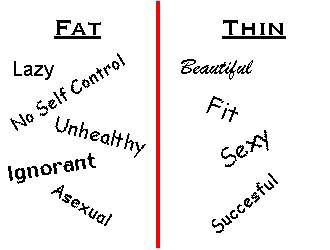Marilyn is now on the board of NAAFA( the national organization). We talked a bit about the upcoming National Convention this summer in San Francisco.

| On March 10th, 2005, Marilyn Wann gave a talk at the University of Colorado At Boulder (CU). This was an event sponsored by CU as part of Body Appreciation month. A few of us from RMNAAFA attended the talk. We even had a chance to chat with her a little bit before hand. Marilyn is now on the board of NAAFA( the national organization). We talked a bit about the upcoming National Convention this summer in San Francisco. |  |
Marilyn began her presentation by talking about how happy she was to be here at the University of Colorado. She said that she was seeing a ground swell of interest around the country on college campuses in the issues surrounding body politics. She also mentioned that she is particularly excited about being at CU, partly because of the fact that Paul Campos is a professor here. His columns about size rights, and his book The Obesity Myth have been a great contribution to size acceptance and body politics.
Marilyn then talked about alienation, and about how this is the primary price that prejudice and bigotry exact on those who are singled out by it. The alienation that is felt by a fat person is particularly deep because they are made to feel like they are not at home in their own body. At that point, where do you go?
Marilyn asked for a show of hands of people who knew at least one person that worried about their weight. With a little coaxing, everyone in the room admitted that they knew at least one such person. Then, she asked for a show of hands of who knew even one person who had never been concerned about their weight. There was a hand or two. Marilyn said that it was her goal to se those two show of hands reversed.
Marilyn then shared with us here personal story about coming out as a fat person. The turning point came for her on a really bad day. This was a day on which she received some very unkind words from a young man she was close to. On the same day, she was also rejected for health insurance because she was morbidly obese (insurance company words).
She then took the energy from this rage and harnessed it into a positive, creative endeavor. This was the point at which she started her zine, Fat!So? The name came to here when she was going over in her mind all of the names she had been called in her life, and she realized she could change the sense of this epitaph with just a little punctuation.
So, she began writing and printing the zine. She did her own printing, and circulated the zine at first through local independent bookstores. What surprised her the most was that as she told people about the zine, and what its focus was, she did not get the reaction she anticipated. She thought that the average person would snicker, chide her, or at least give her a dazed and confused look. What she found instead was that whoever she told the idea to, whether friends, business associated, or (finally) her family, people were universally accepting and excited about the concept. She concluded that, if fact, this was an idea that people were waiting for. The saturation of antifat propaganda in our society had created a real need by people to hear the other side.
As the zine became more successful, Marilyn started to receive invitations to appear on talk shows, radio phone in programs, and other media events. The idea of a fat woman who was happy, healthy, and not trying to loose weight was so novel that it seemed to be a news item.
It was around this time that a tragedy occurred that underscored the depth of alienation which is felt by young people as a result of size prejudice. A young fat man who had all of the teasing he could stand as a result of his weight decided he could take no more and ended his life. It was at this point that Marilyn started talking at high schools, and trying to bring the message of fat acceptance to young people.
We did an exercise that involved shouting the word fat at the top of our lungs. This led into Marilyn talking about the power of this word, and why she feels it is an important word to embrace, and to capture the power of it.
She discussed some of the alternatives that are used to describe fat people.
The most common term is probably overweight. What is wrong with that word, immediately, is that it is a judgment. It assumes that there is a right weight for every single person, and that a fat person is over that weight. It infers that the fat person should be trying to reach the weight which they are over.
Obese is possibly the second most common term. First of all, Marilyn says that she is not sick. The inference of this word is that being fat is some sort of disease that has to be treated. The nastiest baggage that comes with this word is that it is used by the insurance industry to deny health care coverage to people.
There are other terms, such as plump, large, zoftig, and so fourth, which appear on the surface to be kinder than the word fat. But, the truth is that these words are euphemisms which skate around the taboo that society associates with fat. By not saying what they mean, these words enforce the idea that there is something wrong with being fat, and that it is somehow impolite to refer to a person as fat.
There really is nothing wrong with being fat, and the message needs to be that it is OK to be fat.
The word fat is the truth. It is simple and direct, and describes the person as what they are. If we take back the word fat, and no longer let it be seen as an insult, then we allow for the possibility that a fat person can be beautiful, intelligent, and healthy.
Marilyn then led an exercise where we drew a line down the center of a white board. On one side of the line was written the word fat, and on the other side was written the word thin. The audience was then asked to provide words which were generally associated in our society with these two words. The idea was that we were acting as anthropologists, and just collecting ideas which this society had associated with the two simple descriptive terms.
There was no trouble coming up with terms for either side. On the fat side were words like lazy, sloppy, unhealthy, ignorant, stupid, unsuccessful. On the thin side were words like sexy, healthy, beautiful, and in shape.

|
Marilyn was doing a Yay Scale event in the atrium of the UMC on the next day (Friday, the 11th). A Yay Scale is a scale that has the numbers covered up by almost anything else. Her Yay scale, for example, gives you a compliment when you stood on it, instead of giving you a number. Such a scale can be made from most any ordinary bathroom scale by taking off the little plastic window, covering the numbers on the dial with something less offensive, then putting the little plastic window back. She described the plans for the next day as a three ring circus. |
 |